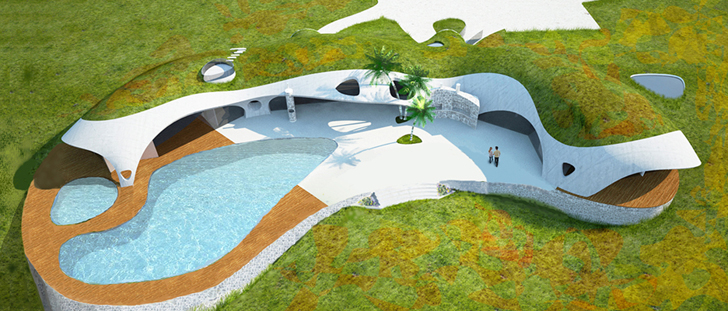How is it made?
The technique used by architect Nicolo Bini is an elementary school tradition. The technique he uses is something similar to that of covering a balloon with papier-mache and popping it after it’s hardened, making stable domes. Binishell works the same way, pouring concrete over an air bladder to create its shape.
Nicolo first starts with a two-dimensional shape in the ground and adds some wood with reinforced steel rebar to form around the air bladder. Then comes the concrete, setting and slowly rising from the ground.
The concrete sets on the form and structural support while an air pump is used to fill the bladder underneath. The concrete then rises to its final shape and the bladder can be removed to be used in another project.
Why inflatable concrete?
These tiny bubble structures were originally meant to be a permanent home and made to survive extreme conditions like earthquakes or lava from a volcano eruption. Nicolo said,
“Binishells have survived even extreme environments such as lava, ash, and constant earthquakes on Mount Etna for almost 50 years.”
Nicolo believes that the structures can be implemented to a variety of different schools and military bases as safe and reliable structures with a fairly simple construction process.
Not only are the Binishells construction process relatively simple but Binishells start at the low price of just $3,500. Making these domes a cheap and affordable way to live. These domes could be a compelling argument for a better alternative to current disaster relief housing we have today. Most disaster relief housing are made to be temporary and a lot of the time end up being shady ghettos.
Concrete makes passive solar heating extremely easy by reducing drain on strained infrastructure. The natural shape of the dome is aerodynamic and can provide protection from the harsh winds of hurricanes.
History of Binishell
Binishell dates back to the mid 1960s to the creator Dr. Dante Bini, father of the architect for the modern Binishells. Dr. Bini’s practice was largely abandoned due to concerns of their stability. Dante’s son now is looking to revive the Binishell method and hopefully provide a low-cost housing solution for everyone around the globe.
Over the years there have been about 1600 of the domed structures put up in over 23 countries. Their sizes range from the size of a gymnasium to as small as a cabin.
Nicolo Bini, the architect, is repositioning these domes as a cheap and modern building solution. Nicolo was quoted saying,
“With 25% of the world’s population living in substandard shelters, this is where we feel we can have the most impact.”
One of these incredible domes was used as a venue at Monash University in Victoria, Australia. Designed by Nicolo’s Father in 1979, the dome stood 11 meters (36 feet) high with 300 tons of concrete, steel, and membrane.
Nicolo and his company have three new models for the Binishell. One is designed for middle income housing and educational facilities. The second is designed for customized private homes and resorts.
Download your 14 Day FREE trial of PlanSwift here:
